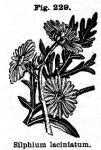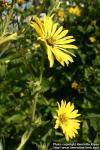Silphium.—Indian Cup-Plant.
 The root of Silphium perfoliatum, Linné.
The root of Silphium perfoliatum, Linné.
Nat. Ord.—Compositae.
COMMON NAMES: Cup-plant, Indian cup-plant, Ragged cup.
Botanical Source.—This plant has a perennial, horizontal, pitted rhizome, beset with radicles, and a large, smooth, square, herbaceous stem, 4 to 7 feet high, and often branched above. The leaves are opposite, connate-perfoliate, ovate, coarsely toothed, abruptly narrowed into winged petioles at the base, the upper pairs forming a cup-shaped disk with their connate bases; they are from 8 to 14 inches long, by 4 to 7 wide. The flowers are terminal, with 15 or 25 oblong, lanceolate, yellow rays, and a large, dark-colored disk. Heads in a trichotomous cyme, the central one on a long peduncle; the scales ovate, obtuse, and squarrose; the achenia broadly ovate, winged, and emarginate (W.—G.).
History, Description, and Chemical Composition.—This plant is common to the western states, and is found growing in rich bottom or interval lands, bearing numerous yellow flowers in August. The root is the medicinal part. It is large, long, and crooked, and imparts its properties to water or alcohol. It has a persistent, acrid taste. There are several species of Silphium, which yield, by incision and exudation, a fine, fragrant, and bitterish gum-like frankincense, of white or amber color, and which is chewed by the Indians to sweeten the breath.
Action, Medical Uses, and Dosage.—Cup-plant is tonic, diaphoretic, and alterative. A strong infusion of the root, made by long steeping, or an extract, is said to be one of the best remedies for the removal of ague-cake or enlarged spleen. It is also useful in intermittent and remittent fevers, internal bruises, debility, ulcers, liver affections, and as a general alterative restorative. The gum is said to be stimulant and antispasmodic. The dose of the powdered root is 20 grains; tincture (fresh root, ℥viij to alcohol, 76 per cent, Oj), 1 to 20 drops, in water.
 Related Species.—Silphium laciniatum, Linné (Silphium gummiferum), Compass-plant, Polar-plant, Compass-weed, Rosin-weed. Western and southwestern United States. This plant, which grows from 5 to 10 feet high, exudes from the stem and leaves transparent or translucent tears of an oleoresin resembling gum mastich, and possessing a pleasant, terebinthinate taste and odor. It consists of volatile oil (20 per cent), acid resin (37 per cent), sugar, wax, and in organic salts (L. J. Morris, Amer. Jour. Pharm., 1881, pp. 487-491). From the fact that the lower leaves of this plant point directly north and south, when growing in open prairie lands, it has received the name "compass- weed." Rosin-weed is said to be emetic in decoction. It has effected cures in intermittent fever, and is beneficial in dry, obstinate coughs, asthmatic affections, and pulmonary catarrhal diseases. Said to cure heaves in horses. The resin secreted by this plant is possessed of diuretic properties, increasing the flow of urine, to which it imparts a strong aromatic odor. The root has been used to some extent in vesical catarrh, gonorrhoea, and gleet. It is a remedy for asthma, with spasmodic, dry cough, with sense of constriction and dryness in the throat; not useful if there be congestion or profuse secretion. It has been employed as an expectorant in cough and other pulmonary difficulties. It as been prepared by cutting it in small pieces, covering each layer with loaf-sugar, and the whole with brandy, After standing for several days, express, strain, and bottle for use. A strong tincture of the fresh plant (℥viii to alcohol, 76 per cent, Oj) may be given in doses of from 1 to 10 drops.
Related Species.—Silphium laciniatum, Linné (Silphium gummiferum), Compass-plant, Polar-plant, Compass-weed, Rosin-weed. Western and southwestern United States. This plant, which grows from 5 to 10 feet high, exudes from the stem and leaves transparent or translucent tears of an oleoresin resembling gum mastich, and possessing a pleasant, terebinthinate taste and odor. It consists of volatile oil (20 per cent), acid resin (37 per cent), sugar, wax, and in organic salts (L. J. Morris, Amer. Jour. Pharm., 1881, pp. 487-491). From the fact that the lower leaves of this plant point directly north and south, when growing in open prairie lands, it has received the name "compass- weed." Rosin-weed is said to be emetic in decoction. It has effected cures in intermittent fever, and is beneficial in dry, obstinate coughs, asthmatic affections, and pulmonary catarrhal diseases. Said to cure heaves in horses. The resin secreted by this plant is possessed of diuretic properties, increasing the flow of urine, to which it imparts a strong aromatic odor. The root has been used to some extent in vesical catarrh, gonorrhoea, and gleet. It is a remedy for asthma, with spasmodic, dry cough, with sense of constriction and dryness in the throat; not useful if there be congestion or profuse secretion. It has been employed as an expectorant in cough and other pulmonary difficulties. It as been prepared by cutting it in small pieces, covering each layer with loaf-sugar, and the whole with brandy, After standing for several days, express, strain, and bottle for use. A strong tincture of the fresh plant (℥viii to alcohol, 76 per cent, Oj) may be given in doses of from 1 to 10 drops.
Silphium terebinthinaceum, Linné, Prairie burdock.—Also yields a resinous exudate.

